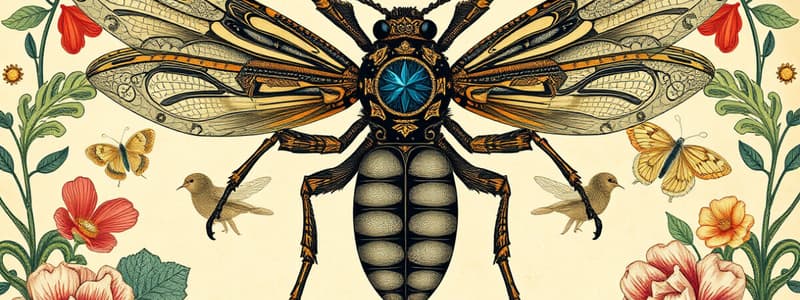Podcast
Questions and Answers
Which feature is common to all insects in the subphylum Hexapoda?
Which feature is common to all insects in the subphylum Hexapoda?
- Compound eyes
- Two pairs of wings
- Six legs attached to the thorax (correct)
- Ability to fly
What do the compound eyes of insects enable them to do?
What do the compound eyes of insects enable them to do?
- Detect sound
- See images and colors (correct)
- Smell chemicals
- Taste food
What advantage does flight provide to insects?
What advantage does flight provide to insects?
- It reduces their need for food
- It exclusively aids in mate selection
- It helps escape from predators (correct)
- It allows for quicker movement over land
Which part of the insect contains most of its internal organs?
Which part of the insect contains most of its internal organs?
What type of circulatory system do insects possess?
What type of circulatory system do insects possess?
How have insect mouthparts adapted over time?
How have insect mouthparts adapted over time?
What structural feature do insect wings share?
What structural feature do insect wings share?
Which of the following is a primary reason for the success of insects?
Which of the following is a primary reason for the success of insects?
What advantage does metamorphosis provide in the insect life cycle?
What advantage does metamorphosis provide in the insect life cycle?
Which of the following insects communicate through pheromones?
Which of the following insects communicate through pheromones?
What is the primary purpose of wings in beetles aside from flight?
What is the primary purpose of wings in beetles aside from flight?
How do honeybees contribute to agriculture?
How do honeybees contribute to agriculture?
Which life stage follows the larva in the mosquito life cycle?
Which life stage follows the larva in the mosquito life cycle?
What is a key characteristic of social insects like ants and bees?
What is a key characteristic of social insects like ants and bees?
In which of the following ways do katydids use their wings?
In which of the following ways do katydids use their wings?
What phenomenon is described by a dramatic increase in locust populations leading to crop destruction?
What phenomenon is described by a dramatic increase in locust populations leading to crop destruction?
What is the primary role of larval ladybug beetles within their ecosystem?
What is the primary role of larval ladybug beetles within their ecosystem?
What unique structure do termites build to house their large colonies?
What unique structure do termites build to house their large colonies?
Which type of insect is known for its extensive hibernation behavior during colder months?
Which type of insect is known for its extensive hibernation behavior during colder months?
What can be a negative effect of insect interactions with humans?
What can be a negative effect of insect interactions with humans?
What aspect of insect behavior is mostly determined by genetic factors?
What aspect of insect behavior is mostly determined by genetic factors?
What critical role do bees play in the environment beyond nectar for honey production?
What critical role do bees play in the environment beyond nectar for honey production?
Flashcards are hidden until you start studying
Study Notes
Insect Overview
- Insects belong to the subphylum Hexapoda, with over 10 million species potentially undiscovered.
- They constitute more than half of all known organisms, showcasing their dominance on Earth.
Physical Structure
- Insects vary in size from less than a millimeter to arm-length.
- Body segments include a head, thorax, and abdomen; they possess six legs attached to the thorax.
- Sensory organs include antennae for chemoreception and sound detection, compound eyes for image viewing, and simple eyes.
- Mouthparts are specialized for diverse diets, aiding in distinct feeding strategies.
Respiratory and Circulatory Systems
- Insects have a complete digestive system, open circulatory system, and a central nervous system.
- Breathing is facilitated through trachea, while excretion occurs via Malpighian tubules.
Flight Adaptations
- Unique to invertebrates, insect flight contributed to their evolutionary success, enabling escape from predators and efficient foraging.
- Typically, insects have two pairs of wings that vary in structure and functionality, allowing for diverse uses, including protection and communication.
Reproductive Strategies
- Predominantly, insects reproduce sexually, although some can reproduce asexually.
- A typical life cycle involves stages of egg, larva, pupa, and adult, with metamorphosis allowing for specialization between life stages.
Behavioral Traits
- Insect behaviors, largely instinctive, include flying and mating, controlled by genetic factors.
- Advanced social behaviors are observed in colonies of ants, bees, and termites, where tasks are divided among specialized roles.
Communication
- Ants utilize pheromones for communication, while honeybees perform a "waggle dance" to relay information about food sources.
Specific Insect Examples
- Ladybugs undergo a four to six-week life cycle, with a predatory role as larvae and adults primarily eating aphids.
- Honeybees are crucial for pollination, influencing the reproduction of over 130 fruit and vegetable varieties in the U.S.
Insects and Human Interaction
- Insects can be beneficial, aiding in pollination, but also pose threats by transmitting diseases and harming crops.
- Notable diseases spread by insects include malaria from mosquitoes and the bubonic plague via fleas.
- Swarms of locusts can devastate agricultural land, highlighting the dual impact insects have on human life.
Summary
- Insects, as the most numerous arthropods, exhibit complex forms and behaviors.
- Their ecological roles are vital for both agricultural systems and natural ecosystems, despite their potential to cause harm.
Studying That Suits You
Use AI to generate personalized quizzes and flashcards to suit your learning preferences.




